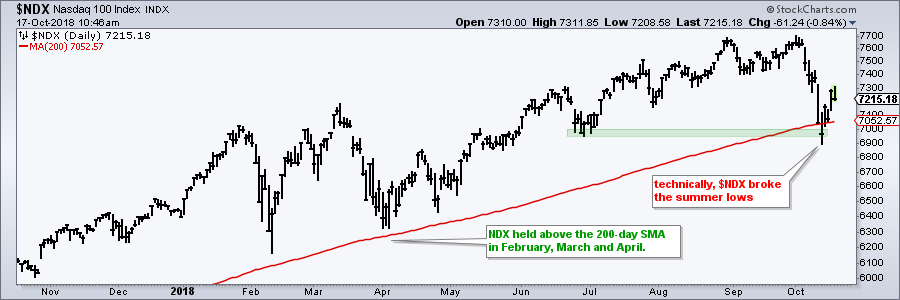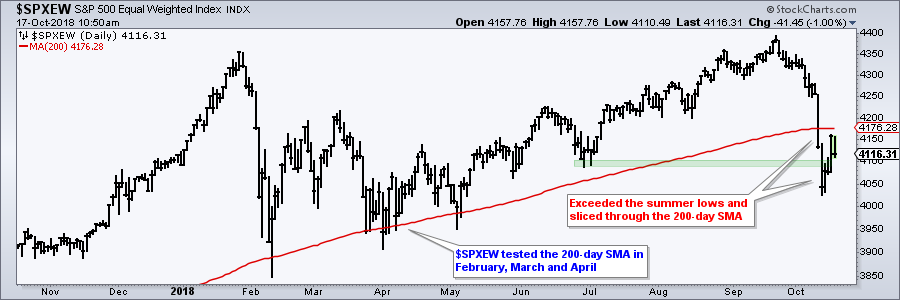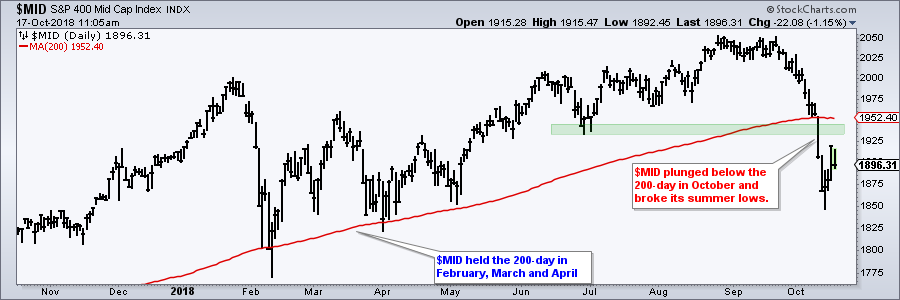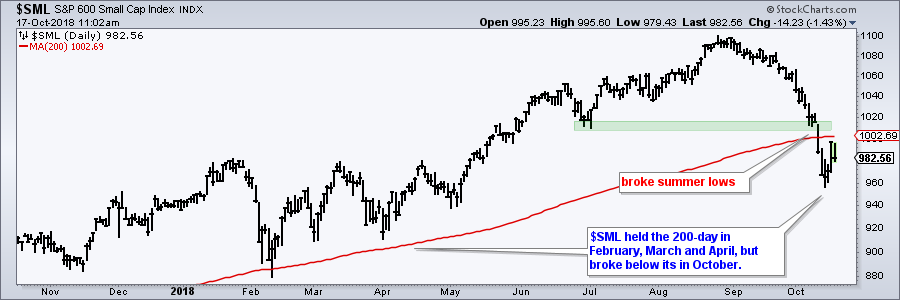 The 200-day SMA acts as a benchmark we can use to compare price movements. We can use the 200-day SMA to compare the current decline in the S&P 500 against past declines. We can also use the 200-day SMA to compare the decline in the S&P 500 with declines in the other key indexes. For example, indexes still below the 200-day are lagging the S&P 500.
The 200-day SMA acts as a benchmark we can use to compare price movements. We can use the 200-day SMA to compare the current decline in the S&P 500 against past declines. We can also use the 200-day SMA to compare the decline in the S&P 500 with declines in the other key indexes. For example, indexes still below the 200-day are lagging the S&P 500.
With this in mind, I will compare recent price action with the period from February to March. How did the different indexes perform relative to their 200-day SMAs? I will also use the summer lows as "benchmark" lows. Indexes, ETFs and stocks breaking these lows are leading lower, while indexes, ETFs and stocks holding above these lows show some relative strength. I will focus on five indexes and three of the five are clearly not performing well.
The S&P 500 is acting similar to the February-April period when it tested the 200-day SMA a few times. The index again tested the 200-day in October by moving below last week and rebounding with a move right back above. Note that the index held up relatively well because it did not break the July-August lows (summer lows).

The Nasdaq 100 held above the 200-day SMA in February, March and April, but pierced this moving average in October. The index also exceeded the summer lows. Even though $NDX bounced back to the 7300 area, the October decline showed more selling pressure than the prior declines.
 Now the real trouble starts. The S&P 500 Equal-Weight Index ($SPXEW) tested the 200-day EMA in February-March-April and then broke below it in October. This index also exceeded its summer lows. Clearly, the October decline was worse than the February decline.
Now the real trouble starts. The S&P 500 Equal-Weight Index ($SPXEW) tested the 200-day EMA in February-March-April and then broke below it in October. This index also exceeded its summer lows. Clearly, the October decline was worse than the February decline.
 The S&P Mid-Cap 400 and S&P Small-Cap 600 also weakened considerably in October. Both held the 200-day SMA in February, March and April, but broke below it in October and remain below it. Selling pressure in October was much stronger than in February. Both indexes also broke the summer lows.
The S&P Mid-Cap 400 and S&P Small-Cap 600 also weakened considerably in October. Both held the 200-day SMA in February, March and April, but broke below it in October and remain below it. Selling pressure in October was much stronger than in February. Both indexes also broke the summer lows.

 While the S&P 500 is holding up the best of these five, the bulk of the evidence suggests that selling pressure in October was worse than February and there is widespread weakness in the stock market. Combined with the bearish signals generated by key breadth indicators last week, the bulk of the evidence looks bearish right now for the stock market.
While the S&P 500 is holding up the best of these five, the bulk of the evidence suggests that selling pressure in October was worse than February and there is widespread weakness in the stock market. Combined with the bearish signals generated by key breadth indicators last week, the bulk of the evidence looks bearish right now for the stock market.
Food for Thought
I don't focus much on the fundamentals, but hardware hacking in China could be a game changer for semiconductor and hardware manufacturers. Here is a detailed article from Bloomberg.
On Trend on Youtube
Available to everyone, On Trend with Arthur Hill airs Tuesdays at 10:30AM ET on StockCharts TV and repeats throughout the week at the same time. Each show is then archived on our Youtube channel.
Topics for Tuesday, October 16th:
- Volatility Increases when Below 200-day (Risk On/Off)
- Don't Estimate Depth or Duration (Dow Theory)
- Scanning for Above/Below 200-day (Weight of Evidence)
- The Game Changer for Tech (SOXX, XSD)
- Commodity Review (Gold, Oil, Palladium)
- Click here to Watch
Questions, Comments or Feedback?
I cannot promise to response to all correspondence, but I will read it and take into under consideration. I greatly appreciate all feedback because it helps me improve the commentary and provides ideas for the future. Sorry, I do not take symbol requests.

Plan Your Trade and Trade Your Plan.
- Arthur Hill, CMT
Senior Technical Analyst, StockCharts.com
Book: Define the Trend and Trade the Trend
Twitter: Follow @ArthurHill






